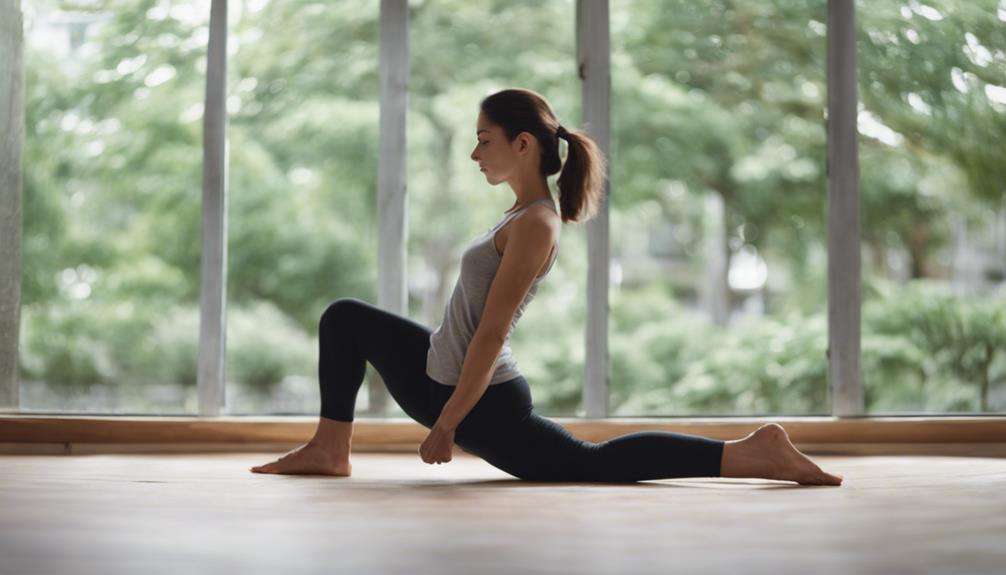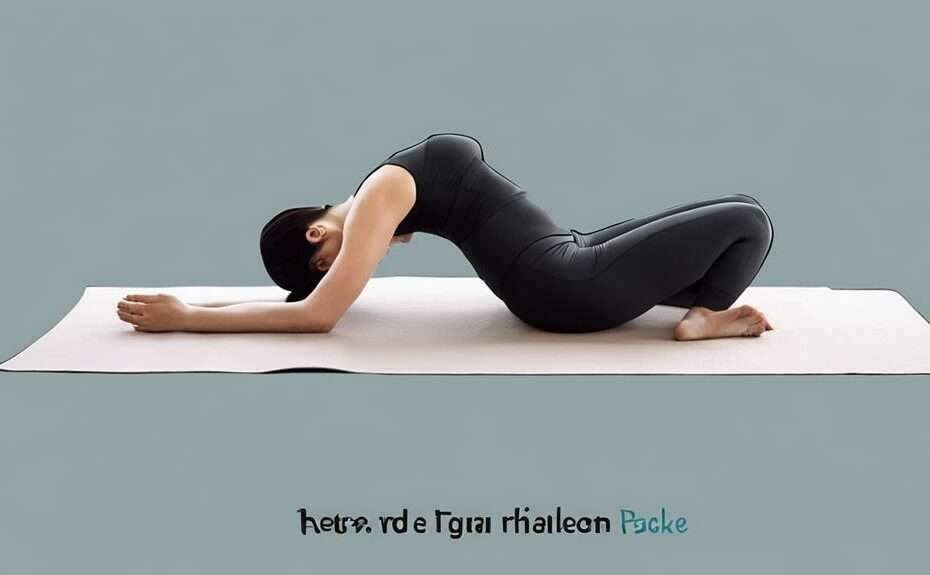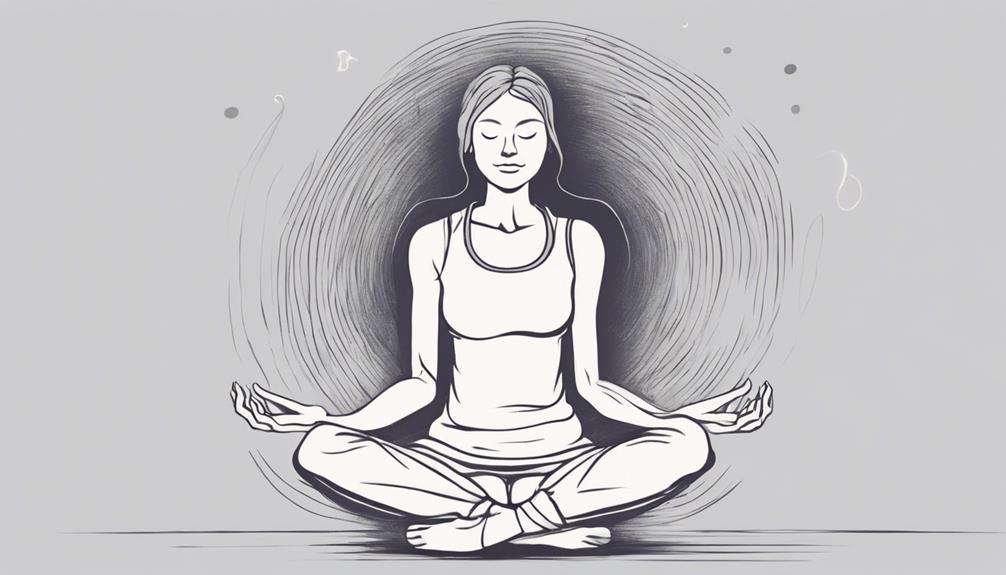If you've been experiencing discomfort in your lower back and hips, exploring gentle yoga poses could offer some relief. By incorporating specific poses that target the affected areas, you may find a way to ease the sensations associated with sciatic nerve pain.
These poses not only aim to alleviate immediate discomfort but also work towards strengthening and increasing flexibility in key muscle groups. Embracing a mindful and progressive yoga practice could hold the key to managing and reducing sciatic nerve pain in the long run.
Key Takeaways
- Yoga stretches alleviate sciatic nerve pain by reducing inflammation and strengthening muscles.
- Poses like Cobra and Locust strengthen the spine and back muscles for relief.
- Child's Pose targets lower back, hips, and thighs to promote relaxation and reduce pain.
- Sphinx Pose elongates the spine, releasing pressure on the nerve for pain relief.
Understanding Sciatic Nerve Pain
When considering sciatic nerve pain, it's important to understand the underlying causes and symptoms that contribute to this often debilitating condition. Sciatic nerve pain originates in the lower back and can radiate through the hip and down the leg, causing sharp pain, numbness, or weakness in the affected area. One of the primary culprits behind sciatic nerve pain is a herniated disc in the spine, which can compress the nerve and trigger these distressing sensations. The muscles surrounding the sciatic nerve can also play a significant role in exacerbating the discomfort when they become tight or inflamed.
Engaging in specific yoga stretches can help alleviate some of the pressure on the sciatic nerve and promote relief from the pain. By targeting the muscles in the lower back, hips, and legs, yoga can improve flexibility and strengthen the muscles that support the spine, potentially reducing the frequency and intensity of sciatic nerve symptoms. Understanding how the sciatic nerve interacts with the surrounding muscles and structures is crucial in developing a comprehensive approach to managing and finding relief from this condition.
Benefits of Yoga for Sciatica
Yoga offers numerous benefits for individuals experiencing sciatic nerve pain.
By strengthening muscles, improving flexibility, and promoting relaxation, yoga helps alleviate discomfort and enhance mobility.
Specific poses like Cobra, Sphinx, and Half Lord of the Fishes target areas affected by sciatica, aiding in pain relief.
Yoga Benefits for Sciatica
Regular practice of yoga offers significant benefits for individuals suffering from sciatica. Yoga helps by reducing inflammation, improving flexibility, and strengthening key muscle groups in the lower back and hips. Specific poses target the piriformis muscle, hamstrings, and lower back to alleviate pressure on the sciatic nerve.
This can aid in relieving chronic lower back pain associated with sciatica and enhance overall well-being. Furthermore, yoga promotes mental well-being through mindfulness and relaxation, providing stress relief that's particularly beneficial for managing the discomfort of sciatic nerve pain.
Poses for Pain Relief
For individuals seeking relief from sciatic nerve pain, specific yoga poses such as Cobra, Locust Pose, and Child's Pose offer targeted benefits by stretching and strengthening key muscles associated with the condition. These poses can improve flexibility, reduce pain levels, and promote relaxation. Practicing yoga regularly can enhance overall quality of life for those with sciatic nerve pain by targeting specific areas of discomfort.
Yoga is a beneficial complementary therapy for sciatica, aiding in aligning the spine, improving mobility, and reducing inflammation. Incorporating these targeted yoga poses into a routine can provide long-term relief and support for individuals managing sciatic nerve pain.
- Cobra Pose
- Locust Pose
- Child's Pose
Cobra Pose for Pain Relief

Stretching your back muscles and increasing flexibility, Cobra Pose, also known as Bhujangasana, is a beneficial yoga posture for relieving sciatic nerve pain. This pose not only targets the back muscles but also strengthens the spine, opens the chest, and improves posture, all of which can help alleviate pressure on the sciatic nerve.
By engaging the muscles in your lower back and abdomen, Cobra Pose promotes better spinal alignment, reducing discomfort associated with sciatica. Regular practice of this pose can enhance circulation to the lower back, aiding in the healing process for sciatic nerve irritation.
Focusing on proper alignment and incorporating mindful breathing techniques while in Cobra Pose can provide a gentle yet effective way to address sciatic nerve pain and improve overall back health. So, next time you experience sciatic nerve pain, consider incorporating Cobra Pose into your yoga routine for relief and healing.
Locust Pose for Healing
Strengthen your back muscles and alleviate sciatic nerve pain with the beneficial yoga posture known as Locust Pose, or Salabhasana. This pose is particularly effective in targeting the lower back area and promoting healing for individuals experiencing sciatic nerve discomfort. Here's why Locust Pose can be beneficial for you:
- Strengthens Muscles: Locust Pose engages the muscles along the spine, which can help alleviate sciatic nerve pain by providing support and stability to the lower back.
- Improves Spinal Alignment and Posture: By practicing Locust Pose regularly, you can enhance your posture and align your spine properly, reducing the pressure on the sciatic nerve and promoting overall spinal health.
- Enhances Flexibility, Range of Motion, and Circulation: This yoga posture not only increases flexibility and range of motion in the lower back but also promotes circulation, aiding in the healing process for sciatic nerve pain. Incorporating Locust Pose into your routine can contribute significantly to relieving tension and discomfort associated with sciatica.
Sphinx Pose for Comfort

Sphinx Pose offers relief from sciatic nerve pain by stretching the spine and opening the chest, improving flexibility in the lower back.
Proper alignment in Sphinx Pose engages core muscles, lengthens the spine, and reduces nerve pressure, aiding in strengthening back muscles to support the spine and alleviate sciatic symptoms.
Modifications in Sphinx Pose can be made for comfort to enhance the benefits of this pose for relieving tension and promoting better posture.
Sphinx Pose Benefits
Enhance your comfort and ease with a pose that targets sciatic nerve pain relief through spinal flexibility and chest opening. Sphinx Pose offers numerous benefits that can help alleviate discomfort and enhance your well-being:
- Stretching: Sphinx Pose stretches the spine, chest, and shoulders, promoting flexibility and relieving tension.
- Improved Posture: This pose helps improve spinal flexibility, which can in turn enhance posture and reduce strain on the lower back.
- Strengthens the Spine: Sphinx Pose strengthens the spine, particularly stimulating the sacral and lumbar regions, offering support and stability.
Incorporating Sphinx Pose into your yoga routine can aid in alleviating sciatic nerve pain and promoting overall relaxation and well-being.
Proper Sphinx Alignment
Wondering how to achieve optimal comfort and alignment in Sphinx Pose for relief from sciatic nerve pain? Proper alignment in Sphinx Pose is key to reducing pressure on the lower back, aiding in sciatica relief. Engage your core muscles to support the spine, promoting stability and comfort during the pose.
Ensure your elbows are directly under your shoulders to maintain a neutral spine alignment, crucial for effective practice. Relax your shoulders and neck to prevent tension build-up, enhancing the pose's benefits for sciatic nerve pain relief. Focus on lengthening your spine in Sphinx Pose to elongate the lower back muscles, easing discomfort associated with sciatica.
Practice these alignment techniques to maximize the relief provided by Sphinx Pose.
Modifications for Comfort
For increased comfort and support in Sphinx Pose, consider utilizing props such as blankets or bolsters to enhance your practice. To make adjustments for comfort during Sphinx Pose, you can:
- Place a cushion under your hips to relieve pressure on the lower back.
- Modify your arm position to accommodate limited mobility or flexibility.
- Adjust the height of the prop under your chest to customize the intensity of the stretch.
Additionally, adding a folded towel under your forehead can enhance relaxation, while a folded blanket under your forehead can help customize the stretch to your needs. These modifications can make Sphinx Pose more accessible and beneficial for individuals experiencing sciatic nerve pain.
Child's Pose for Relaxation

Stretching into Child's Pose can offer relaxation and relief for those experiencing sciatic nerve pain. Child's Pose, also known as Balasana, targets the lower back, hips, and thighs, providing a gentle stretch that can help alleviate the discomfort associated with sciatica.
This restful pose is particularly effective in reducing tension in the back and buttocks, areas commonly affected by sciatic nerve pain. By elongating the spine and releasing pressure on the sciatic nerve, Child's Pose offers a soothing sensation that can bring relief.
Moreover, this pose aids in opening up the hips and stretching the lower back, which not only improves circulation but also promotes healing in the affected area. Regular practice of Child's Pose can contribute to enhanced flexibility, reduced inflammation, and the alleviation of symptoms related to sciatic nerve pain.
Embrace this calming posture to ease your sciatica woes and promote overall well-being.
Cat-Cow Stretch for Mobility
Engage in the Cat-Cow stretch to enhance spinal mobility and flexibility, promoting a healthy range of motion in your back and hips. This dynamic stretch involves arching and rounding the back, which can alleviate tension in the lower back and hips.
Here's how the Cat-Cow stretch can benefit you:
- Spinal Movement: The Cat-Cow stretch encourages gentle movement of the spine, helping to improve flexibility and reduce stiffness.
- Breath Synchronization: By coordinating your breath with the arching and rounding of your back, you can enhance relaxation, reduce stress, and promote a sense of calm.
- Circulation: Regular practice of the Cat-Cow stretch can boost circulation, aiding in the delivery of oxygen and nutrients throughout your body for improved overall well-being.
Incorporating the Cat-Cow stretch into your routine can't only increase your mobility and flexibility but also provide relaxation and stress relief, making it a valuable addition to your daily practice.
Reclined Hand to Big Toe Pose

Begin by lying on your back to practice the Reclined Hand to Big Toe Pose, a beneficial stretch for relieving sciatic nerve pain. This pose targets the hamstrings, calves, and hips, helping to alleviate tension in the lower back and along the sciatic nerve.
By stretching these areas, you can improve flexibility in both legs, reducing the pressure on the sciatic nerve that may be causing discomfort. The Reclined Hand to Big Toe Pose can be particularly helpful in releasing tightness in the hamstrings, which can contribute to sciatic nerve irritation.
Additionally, this stretch promotes better circulation in the legs, aiding in the overall health of the sciatic nerve. Remember, you can modify this pose by using a strap or towel if you have limited flexibility in reaching for your toes.
Regular practice of this pose can gradually decrease sciatic nerve irritation and improve your overall comfort.
Wind Relieving Pose for Relief
To continue relieving sciatic nerve pain, consider incorporating the Wind Relieving Pose (Pavanamuktasana) into your yoga routine. This pose offers various benefits that can help alleviate discomfort and promote overall well-being:
- Digestive Health: Pavanamuktasana aids in relieving gas and bloating in the digestive system, improving overall digestion.
- Lower Back and Hips: By stretching and releasing tension in the lower back and hips, this pose helps reduce sciatic nerve pain and stiffness in the lumbar region.
- Blood Circulation and Relaxation: Practicing Wind Relieving Pose promotes better blood circulation in the abdominal area, leading to relaxation and providing relief from sciatica symptoms.
Incorporating Wind Relieving Pose into your daily yoga practice can't only help in alleviating sciatic nerve pain but also contribute to better digestion, improved flexibility in the lower back and hips, and enhanced overall well-being. Make sure to practice this pose correctly and consistently to experience its full benefits.
Frequently Asked Questions
What Type of Yoga Is Good for Sciatica Pain?
For sciatica pain relief, consider gentle stretches, hip openers, and restorative poses in your yoga practice. Prioritize proper alignment, breath awareness, and mindful movements to strengthen your core and improve flexibility.
What Are the Top 3 Exercises for Sciatica?
For sciatica relief, try chair yoga, Child's pose, and standing poses. Incorporate gentle stretches, pelvic tilts, and core strengthening. Include hip openers, seated twists, and forward folds. Focus on leg stretches to alleviate discomfort.
What Position Relaxes the Sciatic Nerve?
Stretching exercises like Downward-Facing Dog can help you relax the sciatic nerve. Incorporating yoga therapy into your routine may aid in pain management and nerve mobilization, offering relief from nerve compression through gentle yet effective poses.
How Do You Get Immediate Relief From Sciatic Nerve Pain?
To get immediate relief from sciatic nerve pain, apply a hot compress, practice gentle stretches, do deep breathing, use ice therapy, get a massage, target acupressure points, find pain relief, try meditation techniques, utilize heat therapy, and consider essential oils.
Conclusion
Incorporating these yoga poses into your routine can help alleviate sciatic nerve pain by stretching and strengthening key muscle groups.
With consistent practice and proper alignment, you can improve flexibility, reduce nerve compression, and find long-term relief.
So, roll out your mat, take a deep breath, and start your journey towards a healthier, pain-free back with these beneficial yoga poses.






